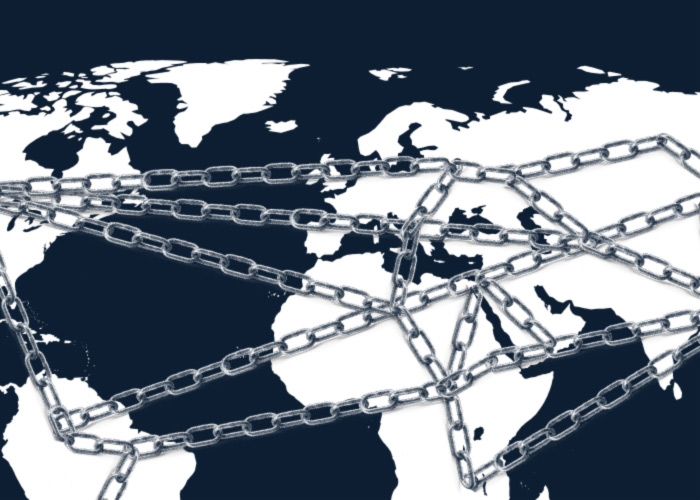Decentralization of Blockchain Networks: Myth or Reality?

Bitcoin: The Biggest Blockchain Network

Bitcoin is the largest and most well-known blockchain network. According to Bitnodes, the network of the first cryptocurrency has 45,685 nodes, of which 17,108 are active. Here and below are the numbers current as of June 15, 2023.
The top three countries by geographic distribution among all nodes are:
- USA — 10,442 (30.57%);
- Germany — 4,679 (13.7%);
- Canada — 1,561 (4.57%).
The distribution by country is slightly different among active nodes:
- USA — 1,670 (9.76%);
- Germany — 1,372 (8.02%);
- France — 460 (2.69%).
Bitnodes data shows that 10,503 (61.46%) of all active Bitcoin network nodes operate through the Tor network (TOR), so it’s impossible to establish their exact geography. There’s also no data on the placement of nodes on large cloud services.
A detailed examination reveals that there isn’t much information about the structure of the Bitcoin network. In addition to Bitnodes, there’s another research service organized by specialists from the Karlsruhe Institute of Technology (KIT). It tracks approximately 7,500 active nodes of the Bitcoin network, a database of which was collected between 2015 and 2018.
The geographic locations of the nodes are:
- USA — approx. 2,500;
- Germany — approx. 1,400;
- France — up to 500.
The proportions are similar to Bitnodes’ data, but more interestingly, the KIT service shows the distribution of nodes by major cloud providers:
- Hetzner Online — approx. 840;
- DigitalOcean — approx. 500;
- Amazon — approx. 350.
The French service OVHcloud and the U.S. Google Cloud follow close behind. It should be noted that up to half of all the nodes of the Bitcoin network monitored by the KIT are located on the servers of large centralized service providers.
Ethereum: The Most Open Blockchain Network

Unlike Bitcoin, comprehensive data on Ethereum’s structure can be found on the Ethernodes service. The network of the largest altcoin includes 8,461 nodes, 5,845 of which were active at the time of this writing. The top three countries where Ethereum nodes are located include:
- USA — 3,924 (46.38%);
- Germany — 982 (11.61%);
- Singapore — 384 (4.54%).
Statistics are given for all nodes, however, filtering out only synchronized nodes won’t change the top three. However, the structure of node distribution between major hostings and other deployment options is much more interesting. For example, centralized cloud providers account for 5,395 (63.75%) of all nodes, while “home” deployments are typical for 2,886 (34.10%) nodes. Among the biggest hosting services where Ethereum nodes are deployed are:
- Amazon — 3,199 (64.7%);
- Hetzner Online — 265 (5.4%);
- Google Cloud — 250 (5.2%).
The decentralized nature of Ethereum is largely dependent on the centralized cloud provider Amazon.
Other Top 10 Blockchain Network Projects

More details on other major blockchain networks:
- BNB Chain, Binance’s blockchain network. According to BscScan, the network has 2,465 active nodes. Of those, 1,412 (57.21%) are hosted in the United States. No data on cloud hosting is available.
- XRP Ledger (XRPL), Ripple’s blockchain network. The network’s internal statistics indicate that 691 nodes are active. There are 228 nodes hosted in Europe, 120 in the U.S., large nodes are hosted in Japan and Singapore, and 229 nodes aren’t tracked on the map. No data on cloud hosting is available, but Ripple is actively engaging university structures to host nodes.
- The Cardano blockchain network has about 3,000 active node validators, which, due to the nature of the network’s consensus algorithm, are large pools. There’s no information on cloud hosting.
- Dogecoin. According to Blockchair, the project’s blockchain network has 729 active nodes, 44% of which are deployed in the United States.
- Tronscan reports that the Tron blockchain network is served by 7,492 nodes deployed in 76 countries. The largest host country is China, with 1,478 nodes. The United States and Germany rank second and third, with 1,256 and 786 nodes, respectively.
- The Solana blockchain network is supported by 278 nodes. Judging by the visualization of the validator map, servers are evenly distributed between the U.S. and Europe.
Reliable information on hosting large blockchain networks on cloud servers is hard to find. However, several major companies offer services to run nodes on different platforms. First and foremost, these are large cloud hosting services that are centralized platforms. The scale of use of such platforms is clearly seen in the example of the biggest blockchain networks — Bitcoin and Ethereum.
In summary, the full-scale practical decentralization of blockchain networks at the current stage of blockchain industry development raises some doubts and requires more detailed research.











